
Monday, September 26, 2016
By Stephanie Dickrell
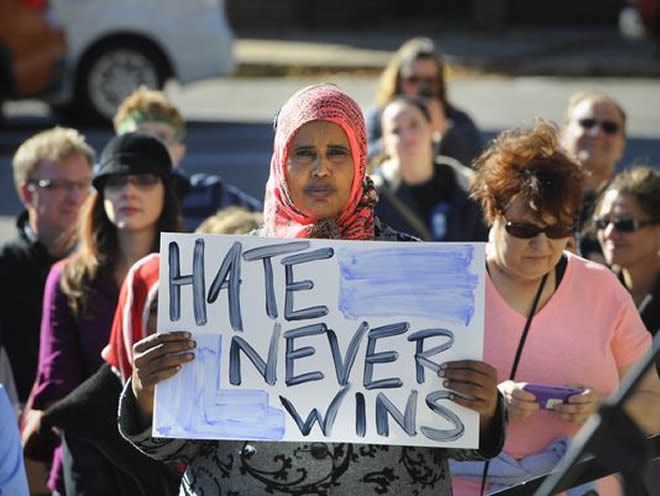
People hold signs during an anti-racism rally and march in Oct., 2014, at the Stearns County Courthouse in St. Cloud. (Photo: Dave Schwarz)
ST. CLOUD, Minn. — The story of the Somali population in St. Cloud starts like many other American immigrant tales: They came as refugees from war in their homeland, in search of opportunity.
But since 9/11, Muslims and immigrants around the country have been under suspicion — as unpatriotic, as terrorists, as outsiders, as dangerous. On Sept. 17, one man seemed to confirm those suspicions when he used a knife to attack 10 people in St. Cloud's Crossroads Center mall before being killed by an off-duty police officer.
Many in the community hoped the perpetrator would be neither Somali nor Muslim.
In fact, 20-year-old Dahir Adan was both, although the reason for the attack is still unknown. Islamic State claimed responsibility, but there is as yet no evidence to connect Adan to the terror group. The investigation has been turned over to the FBI.
Hours after the attacks, Somali leaders were quick to show their sympathy for victims and their families. They described the attack as an act of a single individual, not a community. They say the whole community was victimized by the attack, as were Adan's family and friends and the Somali community, which fears misplaced retaliation.
Somalis have spent a lot of time in St. Cloud proving themselves as neighbors, employees and students. The Somali population started to grow in the early 2000s, where previously there had been only a handful among the St. Cloud metro area's 190,000 residents.
According to the Census Bureau’s 2014 American Community Survey one-year estimates, there are about 428,000 foreign-born people living in Minnesota, about 7.8 percent of the state's total population. The population of foreign-born residents in St. Cloud is estimated at about 5,800, and about 10,500 in the metro area, according to the Census Bureau.
The Minnesota State Demographic Center estimates that there are between 40,200 and 52,400 Somalis in Minnesota, with between 950 and 1,900 Somali-Americans living in St. Cloud. Roughly 200 new refugees are resettled annually in St. Cloud, the majority of which are Somali.
Somali people moved to St. Cloud to work in meat processing and manufacturing plants. Most were secondary refugees, who moved to the area after being settled in other parts of the state or country.
They have found St. Cloud to be particularly close-knit and insular. A vast majority of the area's residents are white and almost 40 percent in the three-county area -- Stearns, Benton, and Sherburne counties -- identify with their German heritage.
According to Minnesota historian Annette Atkins, it was a combination of that heritage and their Catholic religion that made early immigrants to Central Minnesota particularly hostile to outsiders. Those outsiders — Scandinavian and Lutheran Protestants — were also particularly hostile to them. Catholics were in the minority in Minnesota and, during the World Wars, Germans were scrutinized as potential traitors or Nazi sympathizers.
“St. Cloud has not been good at welcoming religious diversity, Atkins said. “I think Stearns County can be a hard place to be not Catholic.”
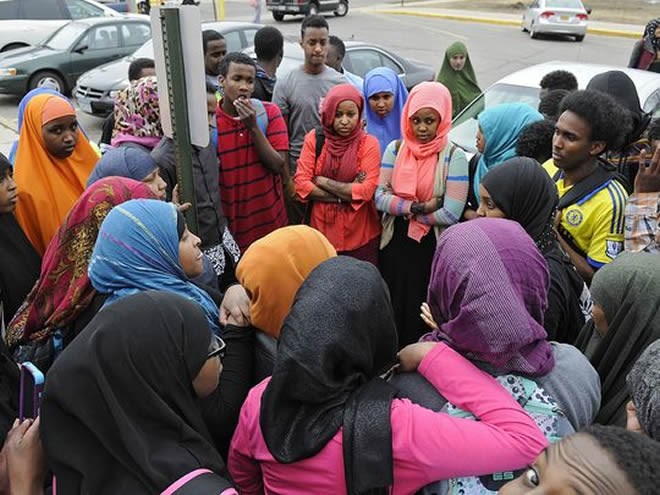
St. Cloud Tech students gather outside the school in March, 2015. More than 100 students and a few parents protested social media posts and other incidents. (Photo: Dave Schwarz)
So Central Minnesota became — and for many, remains — an area where everyone knows everyone and it's assumed most go to Mass on Sundays.
“What shows itself, I think, now as hostility is really fear and self-protection,” Atkins said.
She compared St. Cloud to a large, open city like Los Angeles.
“There, you have to do something really strange to be odd,” she said. “In St. Cloud, you don’t have to be very odd to be odd.”
St. Cloud has seen other waves of immigrants. In the 1970s, about 1,400 Vietnamese refugees were settled here. There's little trace of that community left in St. Cloud, as most moved to the more diverse Twin Cities area.
Early Somali arrivals to St. Cloud said the new Somali workers were received fairly well — until 9/11.
After that, their dark skin, foreign language and unfamiliar religion made them objects of suspicion. The 2001 terrorist attack also prompted Somali leaders to form organizations to advocate and educate on behalf of their community.
“My daughter … she wants to be integrated into the community. At the same time, even though you have friends, close friends, white friends … you are still the Somali girl. The Muslim girl,” said Jama Alimad, one of the Somali elders in St. Cloud.
In fits and starts, though, Central Minnesota started to adjust over a decade and a half.
Early on, the United Way of Central Minnesota was hosting Islam and Somali education events to overflowing rooms. Stearns County, the largest of the three counties, adjusted its personnel and budgets to meet new needs.
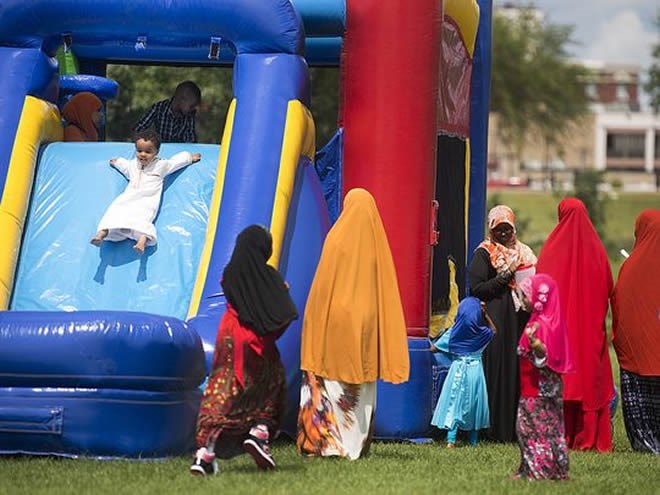
While parts of the community adjusted, others thought the Somali population was here only temporarily. If they ignored the "problem" for long enough, it would go away.
That didn't happen. The same children who came to St. Cloud as preschoolers entered local colleges. Others graduated with professional degrees and started their own businesses. Somalis are beginning to seek election to school and government positions and some Somali families are starting to move to the suburbs.
St. Cloud now has four mosques, one in the heart of the campus of St. Cloud State University and another in a refurbished elementary school. During Ramadan, mosque leaders invite members of the community to experience the breaking of the fast, prayers and the festive meal afterwards.
“They love to live here, the Muslim population. They love the city because it’s a manageable city for them. It’s relatively small. … It’s easy for them to move here, to start their lives here,” said Brianda Cediel, founder of Hands Across the World, a nonprofit that works with refugees. “They consider St. Cloud a very safe city to live.”
In recent years, a faith leaders group that includes a Catholic bishop, Lutheran pastors and Somali elders has achieved a rapport with one another and has plans to further that mission.
But as anti-immigration rhetoric has taken over the national political narrative, the hostility is also evident in St. Cloud. Anti-refugee or anti-Muslim speakers have made numerous stops in Central Minnesota, often to packed houses.
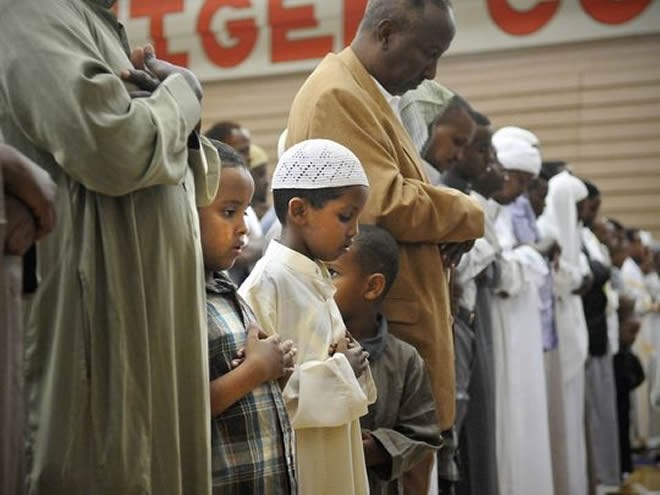
There have been years of conflicts and advances:
— In 2003, freezer manufacturer Electrolux settled a complaint with its St. Cloud workers who said the company failed to accommodate prayer times for its Muslim employees. More than a year before, Electrolux disciplined at least 12 workers for using an "emergency break" for sunset prayers.
— In 2010, the U.S. Department of Education investigated claims of discrimination against Somali students in St. Cloud public schools. A report determined Somali students were taunted and teased.
— Also in 2010, the St. Cloud Times, the largest news organization in the region, launched Somali News video reports to connect with Somali-only speakers in St. Cloud. The content, anchored by reporter Ahmed Abdi, gained an audience in Minneapolis and other parts of the state.
— In 2013, the Islamic Center of St. Cloud withdrew its application to build a mosque after about 500 people attended a public hearing to voice opposition. Two years later, the Islamic Center opened in a former elementary school instead.
— In 2015, Somali students led a protest after a Snapchat photo circulated of a Somali girl in a wheelchair with a caption calling her a terrorist. After the incident, two city residents launched #UniteCloud, a campaign "to resolve tension and restore dignity" in St. Cloud.
— Also in 2015, the community rallied to search for a lost 6-year-old Somali boy, autistic and nonverbal. His body was later found in the Mississippi River, and hundreds expressed their sympathy, setting up a makeshift memorial and donating to a memorial fund.
— In response to residents concerned about the cost of immigration policies, Stearns County in 2015 started releasing a new annual report that examines the amount spent on safety-net programs.
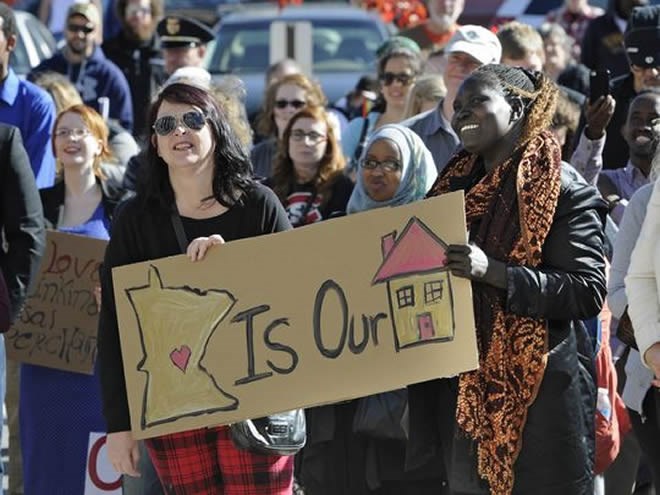
People hold signs while listening to speakers during an anti-racism rally and march in Oct., 2104, at the Stearns County Courthouse in St. Cloud. (Photo: Dave Schwarz)
Still, rumors that refugees get free cars and free tuition to local colleges (both untrue) continue to circulate. There's a persistent, oft-debunked rumor that a Muslim cashier — the story varies about which store she works in — refuses to ring up a customer wearing a cross necklace.
“I think we may be in the habit of fear and fear makes people resist the other. It makes us resist people who are different from ourselves,” Atkins said.
St. Cloud leaders including Police Chief Blair Anderson have urged patience and unity as the investigation into the knife attack at Crossroads Center unfolds. During a Fox News interview last week, Anderson answered a question about fighting terrorism with this:
"We actually work very well not just with our East African community, but all of our community. We meet regularly with any number of people, whether they are advocates for a specific ethnicity or different cause. It’s one of things that makes St. Cloud a wonderful place to live, and I know that might sound corny, but it’s the truth. We have established and maintained a very good rapport with our East African community and our community at large."